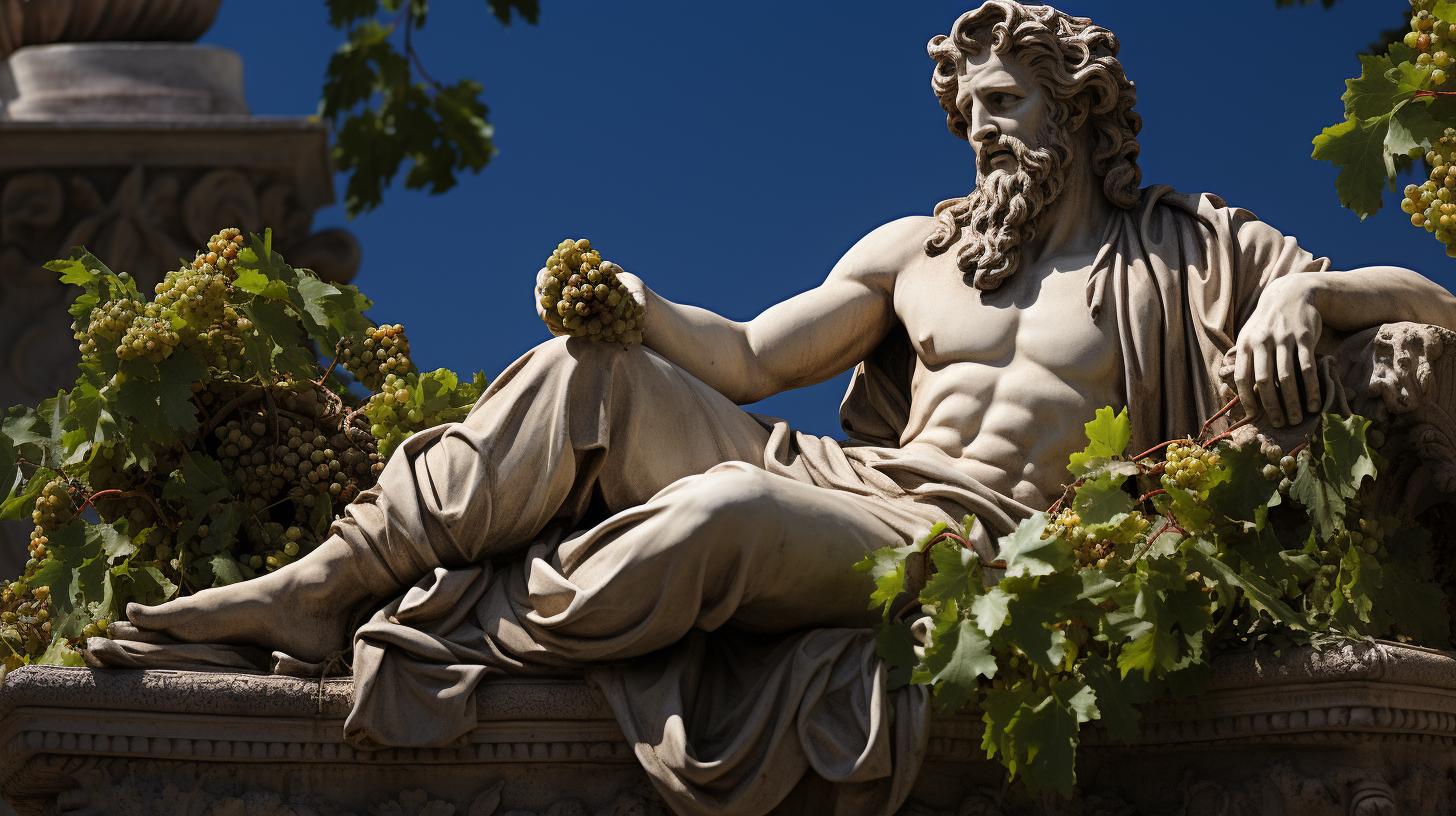Roman God Terminus: Presiding Over Boundaries and Protecting Properties in Ancient Rome

The Roman god Terminus, associated with Jupiter, held a significant role in protecting the boundaries, both of properties and the state. Originating from the worship established by Numa, Terminus was revered through the placement of sacred stones as markers for property limits and annual sacrifices during the Terminalia festival.
The state’s inviolable boundary, represented by Terminus, persisted in the public Terminus located on the road to Laurentum. Additionally, Terminus held a place in the Temple of Jupiter, symbolizing the perpetuity and youthfulness of the Roman state.
Sacrifices and rituals were performed around these boundary markers, emphasizing their sacred nature.
The Origins and Worship of Terminus
The worship of Terminus, the Roman god of boundaries, has ancient origins and played a significant role in both private properties and the state. This section explores the establishment of Terminus worship, his role as the protector of boundaries, the public Terminus as the boundary stone of Ager Romanus, and Terminus’s association with the Temple of Jupiter.
Numa and the Establishment of Terminus Worship
According to ancient beliefs, the worship of Terminus was believed to have been established by Numa, who ordered the placement of consecrated stones as markers for property boundaries.
This act was accompanied by annual sacrifices during the Terminalia festival, demonstrating Numa’s reverence for Terminus.
Terminus as the Protector of Boundaries
Terminus was primarily known as the guardian and protector of boundaries. His divine presence ensured the inviolability of both private properties and the state’s territory. As the deity responsible for protecting limits, Terminus held a significant role in Roman society.
Terminus Publicus: The Boundary Stone of Ager Romanus
One prominent manifestation of Terminus was the Terminus Publicus, a boundary stone located between the fifth and sixth mile on the road to Laurentum. This stone marked the boundary of the Ager Romanus, the sacred territory of Rome.
It was treated with the same reverence and ceremonies as private boundary markers, further emphasizing the significance of Terminus in Roman religious practices.
Terminus in the Temple of Jupiter
The association between Terminus and Jupiter was strong, as Terminus was considered an attribute of the powerful god. In the Temple of Jupiter on the Capitolium, Terminus had a particular place with an opening in the roof , symbolizing that he should not be confined under a roof.
This architectural element highlighted the connection between Terminus and Jupiter, further emphasizing Terminus’s importance in Roman religious beliefs.
The Significance of Terminus
Terminus held great significance in ancient Roman culture, both as an attribute of Jupiter and in the sacred nature of property boundary markers.
Terminus as an Attribute of Jupiter
Terminus was closely associated with Jupiter, the king of gods and the protector of boundaries.
As an attribute of Jupiter, Terminus symbolized the divine authority that governed the limits and frontiers. This association reinforced the belief that the boundaries, whether on private properties or within the state, were inviolable and protected by the divine power embodied by Terminus.
The Sacred Nature of Property Boundary Markers
Property boundary markers, adorned with sacred stones, held immense religious significance in ancient Rome. These markers were considered tangible representations of Terminus and his role in preserving the order and integrity of private boundaries.
Holding sacred ceremonies and sacrifices around these markers further emphasized their significance as divine boundary protectors.
The meticulous observance of annual rituals during the Terminalia festival, celebrated on the 23rd of February, highlighted the sanctity of these markers and the importance of respecting property boundaries.
The Terminalia festival served as a reminder of the divine connection between Terminus, Jupiter, and the well-being of the Roman society as a whole.
The belief in the sacred nature of property boundary markers endured even as the boundaries of the state became less revered over time.
These markers, known for their perpetual significance, continued to be venerated in private properties, preserving the age-old tradition of marking and respecting boundaries.
In conclusion, Terminus’ significance as an attribute of Jupiter emphasized the divine authority that governed boundaries, while the sacred nature of property boundary markers reinforced the importance of respecting and preserving order within the Roman society.
Rituals and Festivals Associated with Terminus
Rituals and festivals played a significant role in the worship of the Roman god Terminus. These ceremonies were dedicated to honoring and appeasing Terminus as the guardian of boundaries. Two important aspects of Terminus worship include the Annual Sacrifices and the Terminalia Festival.
Annual Sacrifices and Terminalia Festival
The Annual Sacrifices were a crucial component of Terminus worship, ensuring the continued protection and sanctity of property boundaries. These sacrifices were performed by property owners at the sacred stones that marked their limits.
It was believed that by offering sacrifices to Terminus, the boundaries would remain secure and any encroachments or disputes would be averted.
The Terminalia Festival, held on the 23rd of February every year, was a grand celebration dedicated to Terminus.
During this festival, people gathered at the boundaries of their properties to honor the god and seek his blessings. Offerings such as cakes, fruits, and sacrificial animals were made to Terminus as a token of gratitude and to ensure the ongoing protection of their boundaries.
The Role of Sacrifices in Terminus Worship
Sacrifices held a central role in Terminus worship. Property owners and individuals would offer animals, fruits, and other symbolic items as acts of devotion and reverence. The sacrifices were seen as a way to establish a connection with Terminus, expressing gratitude for his protection and seeking his continued favor.
These rituals and festivals not only reinforced the sacred significance of boundaries but also fostered a sense of community among property owners and the Roman populace as a whole. The belief in Terminus and the observance of these rituals provided a shared cultural bond, highlighting the importance of respecting and honoring established boundaries.
In conclusion, the rituals and festivals associated with Terminus served as powerful expressions of devotion and reverence towards the Roman god of boundaries. The Annual Sacrifices and Terminalia Festival were integral in maintaining the sanctity and protection of property limits, fostering a sense of communal identity among the Roman people.
The Perpetuity and Youthfulness of Roman State
Terminus as a Symbol of Roman State’s Perpetuity
The worship of Terminus served as a symbolic representation of the perpetuity of the Roman state. The ancient belief in the inviolable nature of property boundaries extended to the boundaries of the state itself.
Just as the sacred markers of private properties remained untouched over time, the boundaries of the state were considered timeless and unchanging.
The presence of Terminus in the Temple of href=”https://oldworldgods.com/romans/roman-god-jupiter/”>Jupiter further emphasized this perpetual nature of the Roman state.
The fact that a Terminus was not allowed to be placed under a roof highlighted its connection to Juptier and its significance as a symbol of divine protection over the boundaries.
Traditions and Beliefs Surrounding Terminus
Ancient Roman traditions and beliefs surrounding Terminus added to the worship and reverence of this deity. It was believed that the sanctuaries of Terminus could not be removed when the Capitolium Temple of Jupiter was founded, signifying the perpetual and youthful nature of the Roman state.
Additionally, writings from antiquity mention the performance of rituals and sacrifices associated with the boundary markers, including the annual Terminalia festival held on February 23rd. These observances and offerings were meant to ensure the continued protection and prosperity of the boundaries, both of private properties and the state.
The traditions and beliefs surrounding Terminus highlight the importance placed on the preservation and respect for boundaries in Roman society. The adherence to these practices served as a testament to the eternal nature of the Roman state and its commitment to maintaining order and structure within its borders.
- Terminus represented the eternal nature of the Roman state.
- Boundaries, both of properties and the state, were considered inviolable.
- Terminus’ presence in the Temple of Jupiter signified divine protection over boundaries.
- Ancient writings mention rituals and sacrifices associated with boundary markers.
- The Terminalia festival was an annual celebration of Terminus.
- The traditions surrounding Terminus emphasized the importance of boundaries in Roman society.
- The perpetuity of the Roman state was symbolized through the traditions and beliefs surrounding Terminus.
Modern Interpretations and Scholarly Views
The Roman god Terminus continues to captivate scholars and researchers, leading to various interpretations and investigations into its significance.
Let’s delve into some key areas of study surrounding Terminus in ancient literature, Roman antiquities, and contemporary perspectives on Terminus worship.
Interpretations of Terminus in Ancient Literature
Ancient literature provides valuable insights into the interpretation of Terminus in Roman society. Scholars meticulously analyze references found in works like Ovid’s “Fasti” and Livy’s “Ab Urbe Condita” to understand the cultural, religious, and social implications associated with Terminus.
These texts often depict Terminus as a protective deity and emphasize the sacredness of boundaries.
Terminus in Roman Antiquities
Roman antiquities and archaeological findings shed light on the material manifestations of Terminus worship. The discovery of boundary stones, inscriptions, and depictions of Terminus in ancient artifacts offer a tangible glimpse into how the Romans revered this deity.
Researchers examine these physical remnants to uncover details about religious practices, rituals, and the significance of Terminus in Roman society.
Contemporary Perspectives on Terminus Worship
The worship of Terminus, although ancient in origin, still holds relevance in contemporary times. Some contemporary scholars explore the enduring cultural legacy of Terminus worship, drawing connections to modern notions of property boundaries and territorial disputes.
Others examine Terminus within the framework of religious syncretism and the blending of ancient and modern beliefs.
Through ongoing research and analysis, scholars continue to deepen our understanding of Terminus and its multifaceted role in the Roman world.
Their findings bring us closer to appreciating the cultural significance and enduring impact of this influential deity.
.




















